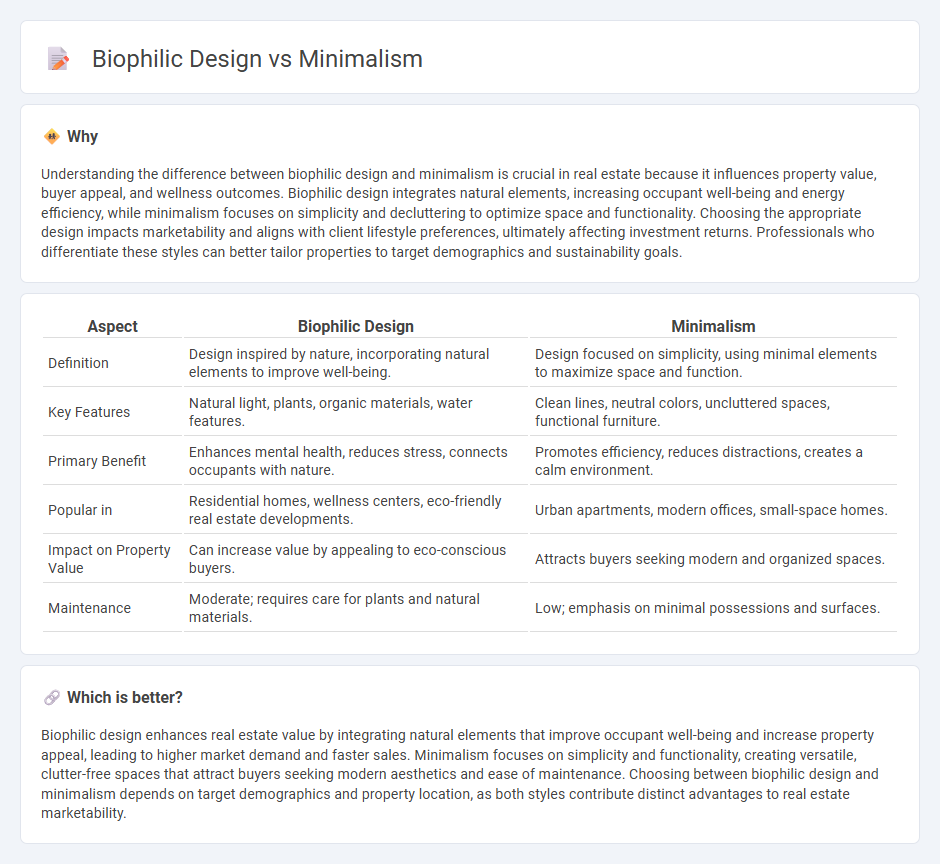
Biophilic design integrates natural elements, such as greenery, natural light, and organic materials, to create spaces that enhance wellbeing and reduce stress. Minimalism emphasizes simplicity, clean lines, and functional spaces, minimizing clutter to promote clarity and calm. Explore how these contrasting real estate design philosophies can transform living environments to suit diverse lifestyle needs.
Why it is important
Understanding the difference between biophilic design and minimalism is crucial in real estate because it influences property value, buyer appeal, and wellness outcomes. Biophilic design integrates natural elements, increasing occupant well-being and energy efficiency, while minimalism focuses on simplicity and decluttering to optimize space and functionality. Choosing the appropriate design impacts marketability and aligns with client lifestyle preferences, ultimately affecting investment returns. Professionals who differentiate these styles can better tailor properties to target demographics and sustainability goals.
Comparison Table
| Aspect | Biophilic Design | Minimalism |
|---|---|---|
| Definition | Design inspired by nature, incorporating natural elements to improve well-being. | Design focused on simplicity, using minimal elements to maximize space and function. |
| Key Features | Natural light, plants, organic materials, water features. | Clean lines, neutral colors, uncluttered spaces, functional furniture. |
| Primary Benefit | Enhances mental health, reduces stress, connects occupants with nature. | Promotes efficiency, reduces distractions, creates a calm environment. |
| Popular in | Residential homes, wellness centers, eco-friendly real estate developments. | Urban apartments, modern offices, small-space homes. |
| Impact on Property Value | Can increase value by appealing to eco-conscious buyers. | Attracts buyers seeking modern and organized spaces. |
| Maintenance | Moderate; requires care for plants and natural materials. | Low; emphasis on minimal possessions and surfaces. |
Which is better?
Biophilic design enhances real estate value by integrating natural elements that improve occupant well-being and increase property appeal, leading to higher market demand and faster sales. Minimalism focuses on simplicity and functionality, creating versatile, clutter-free spaces that attract buyers seeking modern aesthetics and ease of maintenance. Choosing between biophilic design and minimalism depends on target demographics and property location, as both styles contribute distinct advantages to real estate marketability.
Connection
Biophilic design and minimalism intersect in real estate by promoting sustainable, healthy living spaces that emphasize natural elements and simplicity. Incorporating abundant natural light, greenery, and organic materials enhances occupant well-being while minimizing clutter and maximizing functional space. This combined approach increases property value by attracting environmentally-conscious buyers seeking harmony between nature and modern living.
Key Terms
Aesthetics
Minimalism emphasizes clean lines, neutral color palettes, and uncluttered spaces to create a serene and functional environment. Biophilic design integrates natural elements such as plants, natural light, and organic textures to foster a strong connection with nature and enhance well-being. Explore the unique aesthetic approaches of both styles to transform your living space effectively.
Natural Elements
Minimalism emphasizes clean lines and simplicity, often using a neutral palette with limited natural elements to create a clutter-free space. Biophilic design integrates abundant natural elements such as plants, natural light, and organic materials to strengthen the connection between indoor spaces and nature. Explore deeper insights on balancing minimalism with biophilic principles to enhance your living environment.
Functionality
Minimalism emphasizes functionality by reducing spaces to essential elements, promoting simplicity and uncluttered environments that enhance usability. Biophilic design integrates natural elements like plants, natural light, and organic materials, improving functionality through enhanced wellbeing and productivity. Explore more to understand how these design philosophies optimize spaces for both efficiency and human connection.
Source and External Links
Minimalism - Minimalism is an art and lifestyle movement that emphasizes simplicity and the removal of unnecessary elements to focus on what is essential.
What Is Minimalism? - Minimalism involves living intentionally with fewer possessions to focus on what truly matters, promoting clarity and purpose in life.
What Is Minimalism? - Minimalism is a tool to eliminate excess and focus on what is important, leading to happiness, fulfillment, and freedom.
 dowidth.com
dowidth.com